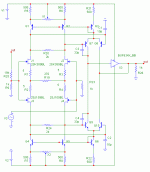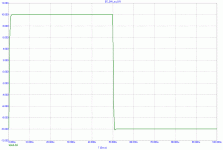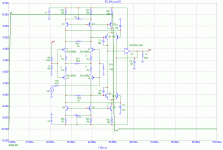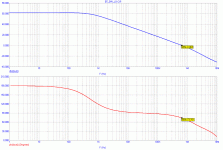PMA said:Started to play as well ... 😀
Try making C1/C2 equal to C3/C4, this should result in PSRR improvement
Ain't common mode feedback cool?🙂 There are other ways to do it, mine is different, but you can't beat dynamic bias for control of a fully differential VAS.
Next try it using constant power..........😉
Next try it using constant power..........😉
PMA said:10nF cap load
Good or bad, this has almost nothing to do with Scott's circuit, but mostly with the buffer model you are using.
I think I have seen this circuit before... not quite sure where at the moment...
Btw, what was the purpose of the 2k resistors between the jfets?
Trying to follow along in my Libretto... 😉
_-_-bear
Btw, what was the purpose of the 2k resistors between the jfets?
Trying to follow along in my Libretto... 😉
_-_-bear
bear said:I think I have seen this circuit before... not quite sure where at the moment...
Btw, what was the purpose of the 2k resistors between the jfets?
Trying to follow along in my Libretto... 😉
_-_-bear
It is possible you have seen this before. A very similar circuit was published in 1990 by William C. Snyder in "Class A Audio Design".
bear said:I think I have seen this circuit before... not quite sure where at the moment...
Btw, what was the purpose of the 2k resistors between the jfets?
Trying to follow along in my Libretto... 😉
_-_-bear
More nodes with "infinte gain" than degrees of freedom. For a particular set of device offsets the DC solution is singular in simulation as well as in reality 🙂 . The 2k resistors allow some differential current to flow when you use current mirrors.
Steve Dunlap said:
It is possible you have seen this before. A very similar circuit was published in 1990 by William C. Snyder in "Class A Audio Design".
As I stated the first time it's was an attempt at a complimentary version of the OPA627. Once you realize the self biased FET's can substitute for the LTP's you can go through and "Muntz" away. I think the first use of this CMFB was by George Erdi at PMI in the 70's. I happen to like this better than the one transistor mis-matched resistor take off, which BTW I don't consider truely full complimentary symmetry. The top and bottom transistors act like an LTP with one side pnp and the other npn.
PMA said:Started to play as well ... 😀
darkfenriz said:
Try making C1/C2 equal to C3/C4, this should result in PSRR improvement
My humble opinion is, to try Zobels in parallel with 2K resistors instead of all that 4 capacitors.
PMA said:Will depend on the CLG gain chosen.
I suppose, UG stability may be sacrificed in lieu of sound quality, right?
scott wurcer said:
As I stated the first time it's was an attempt at a complimentary version of the OPA627. Once you realize the self biased FET's can substitute for the LTP's you can go through and "Muntz" away. I think the first use of this CMFB was by George Erdi at PMI in the 70's. I happen to like this better than the one transistor mis-matched resistor take off, which BTW I don't consider truely full complimentary symmetry. The top and bottom transistors act like an LTP with one side pnp and the other npn.
Hi Scott,
I wasn't trying to imply anything here, just pointing out why the circuit might look familiar to Bear.
"As I stated the first time it's was an attempt at a complimentary version of the OPA627."
Remember, I'm relatively new here and haven't gone back and read all the older threads. Apparently I missed the thread were you stated that the first time.
Hi Scott
The circuit simulates really nice, it wasn’t the circuit that was a bit”funky” it was me that did some”funky” stuff. 🙁
I’m using a bit less FB than Pavel, and I’m getting a slightly better square wave.
BTW thanks Scott
The circuit simulates really nice, it wasn’t the circuit that was a bit”funky” it was me that did some”funky” stuff. 🙁
I’m using a bit less FB than Pavel, and I’m getting a slightly better square wave.
BTW thanks Scott
- Status
- Not open for further replies.
- Home
- Amplifiers
- Solid State
- Return of my differential VAS



